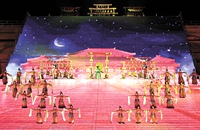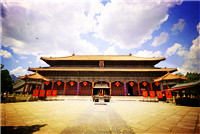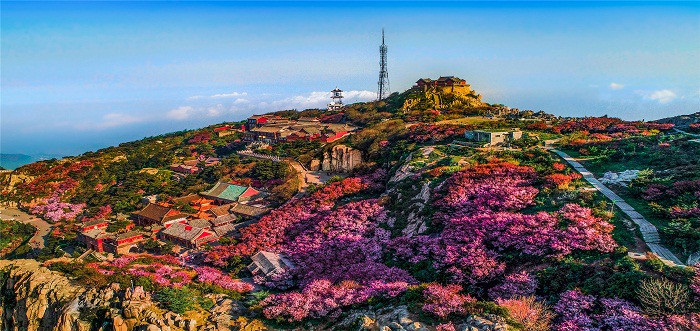A mountain that scales China's history
 |
|
A giant Taoist mural from the Song Dynasty (960-1279) depicts a grand inspection by the deities of Mount Taishan, which features forests, palaces, bridges and 697 people. [File photo] |
Over 3,000 years, Chinese emperors have made pilgrimages to Mount Tai to pray to the gods. Scholars and poets have marveled at the majesty of the mountain and composed poems and prose in honor of it, some inscribing them on the mountain.
Twelve emperors, beginning with Qin Shihuang, the first emperor that unified China in 221 BC, have paid homage in a ritual called "Fengshan Sacrifices" at Mount Tai, said Lyu Jixiang, a researcher with Taishan's management committee.
"There are more than 2,000 rock inscriptions and stone tablets testifying to visits by emperors and scholars," said Lyu.
Lyu said more than 10,000 poems and works of prose have been found.
Located at the foot of the mountain, the Dai Temple is a must-see. Measuring 405 meters by 236 meters, Dai Temple is the largest and best-preserved structure on Mount Tai. Built in the Han Dynasty (206 BC-AD 220) as a site at which emperors paid their respects to the gods, the temple was expanded and renovated by rulers of the Tang (AD 618-907) and Song (960-1279) dynasties.
Han Emperor Liu Che (141-86 BC) visited Mount Tai ten times. It is said the emperor planted 1,000 cypresses at the Dai Temple, thought only five survive today. Two of the five have had their barks stripped but surprisingly some of their branches are still greeting tourists with green leaves.
The Tiankuang Hall, the temple's main structure, houses a giant Taoist mural that is 3.3 meters high and 62 meters long and depicts the god of Mount Tai on an inspection tour. The mural details forests, palaces, bridges, riding beasts and 697 people and was painted during the Song Dynasty.
Parts of the mural have been damaged, though it is slated for repairs this year, said Zhao Peng, deputy director of Tai'an Museum.
The Dai Temple is also called "the forest of stone tablets" because it houses more than 300 stone tablets, Zhao said.
At the summit of the mountain is an address made during one of the "Fengshan Sacrifices" rites that was written by Emperor Li Longji (who reigned from AD 712-756) during the Tang Dynasty.
Emperor Li took the rite seriously. He selected 1,000 horses and a massive army and began his journey to the temple from the then capital of Chang'an. Emperor Li carved his address in an entire cliff to show his achievements.
At the summit, you will also see several monuments marking Confucius' visits.
"The Platform for Viewing Lu Kingdom" is where Confucius scanned over the Chinese kingdom and where an upright slab of stone is inscripted with "Confucius finds the world small".
The Azure Cloud Temple at the summit has become a popular place for people to burn incense and pray for their health and happiness. To protect the environment, the management committee for the mountain has prohibited incenses longer than 50 cm.
Statistics from the local tourism administration shows 48.3 million tourists visited the city last year, generating 44.17 billion yuan ($7.08 billion), which accounted for 15.8 percent of Tai'an's GDP.
In recent years, the local government has introduced several projects to enrich its tourism industry. Among them are performances to re-enact the "Fengshan Sacrifices" at Fanta Wild Adventure Park.

 10 measures to help control epidemic, restart work
10 measures to help control epidemic, restart work 70 Years on: A New Look at Tai'an
70 Years on: A New Look at Tai'an Mt.Taishan--the sacred mountain under heaven 1
Mt.Taishan--the sacred mountain under heaven 1

